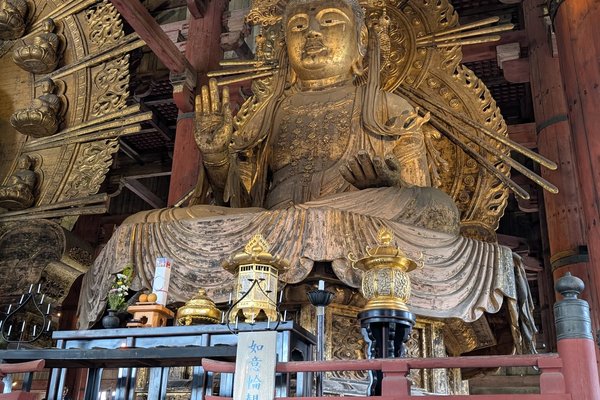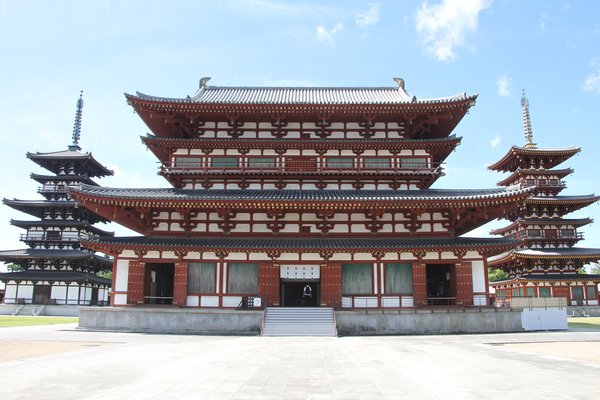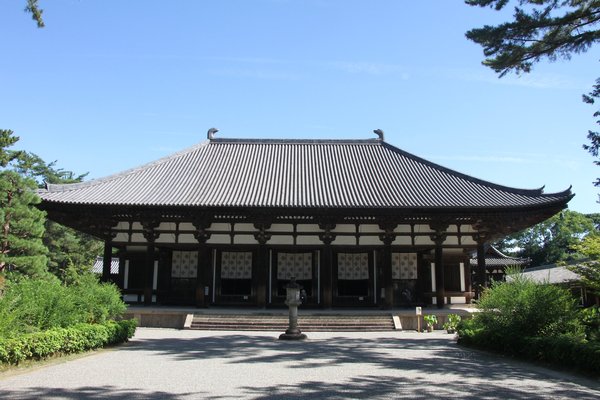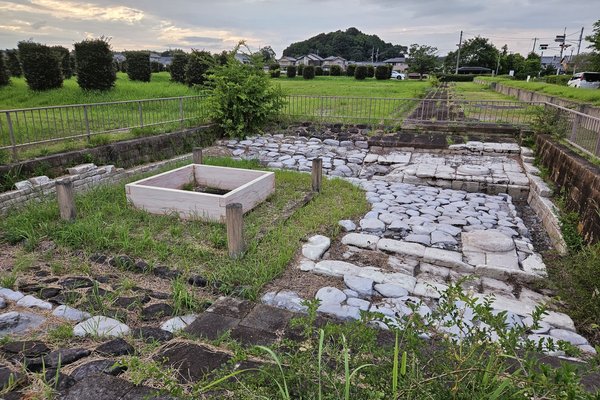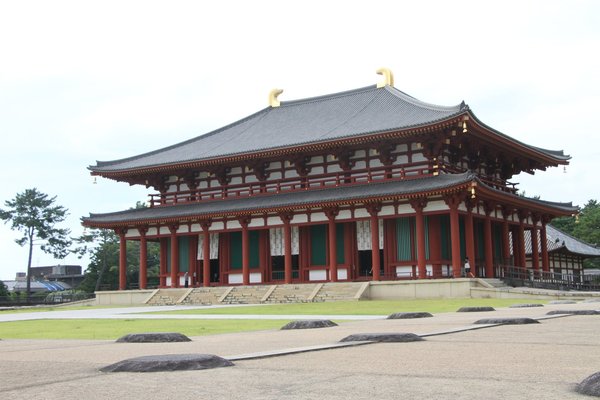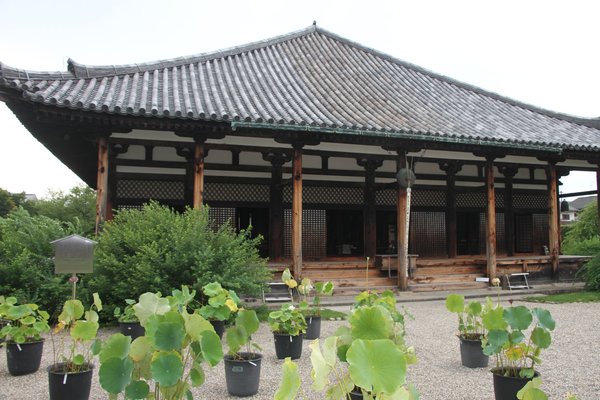Japan
Ancient Nara
The Historic Monuments of Ancient Nara comprise the former Imperial Palace and Buddhist and Shinto religious buildings that show the evolution of Japanese architecture.
From 710-784, Nara blossomed as the capital of Japan. The city was planned according to geomantic principles. Its architecture profited from cultural links with China and Korea. The palace was not only the imperial residence but also had a large number of official buildings used for political and religious ceremonies.
Community Perspective: more manageable than nearby Kyoto, but it is still recommended to stay the night, as there is a lot to see. The main highlight is the oversized Todai-ji. Hubert has described all 8 inscribed locations.
Site Info
Official Information
- Full Name
- Historic Monuments of Ancient Nara (ID: 870)
- Country
- Japan
- Status
-
Inscribed 1998
Site history
History of Ancient Nara
- 1998: Inscribed
- Inscribed
- Type
- Cultural
- Criteria
- ii
- iii
- iv
- vi
Links
- UNESCO
- whc.unesco.org
- Official
-
- visitnara.jp — > Kasugayama Primeval Forest
- nabunken.go.jp — > Nara Palace Site
- toshodaiji.jp — > Toshodai-ji
All Links
UNESCO.org
- whc.unesco.org — whc.unesco.org/
Official Website
- visitnara.jp — > Kasugayama Primeval Forest
- nabunken.go.jp — > Nara Palace Site
- toshodaiji.jp — > Toshodai-ji
- nara-yakushiji.com — > Yakushi-ji
- gangoji.or.jp — > Gango-ji
- kasugataisha.or.jp — > Kasuga-Taisha
- kohfukuji.com — > Kôfuku-ji
- todaiji.or.jp — > Tôdai-ji
- visitnara.jp — Visit Nara
News Article
- Aug. 4, 2023 english.kyodonews.net — Todaiji temple vandalized with cat-like image
- Sept. 27, 2022 asahi.com — Last chance to see pagoda at Kofukuji before repairs start
- Jan. 10, 2021 japantimes.co.jp — National-treasure Yakushiji pagoda in Nara to open to public from March
- March 1, 2020 mainichi.jp — Pagoda at World Heritage temple in Nara to undergo repairs for 1st time in 120 years
- Dec. 4, 2015 ajw.asahi.com — Nara's Great Buddha has a bad hair day
- April 11, 2015 japantimes.co.jp — Spate of vandalization hits Kyoto, Nara World Heritage sites
- Nov. 14, 2014 ajw.asahi.com — Glass dish unearthed in Nara came from Roman Empire
- March 11, 2011 search.japantimes.co.jp — Yakushiji pagoda open first time in 1,300 years
Community Information
- Community Category
- Archaeological site: Far Eastern
Travel Information
One million visitors or more
Kyoto hotspot
Recent Connections
-
Location for a classic movie
Rashomon (1950, won the Golden Lion at … -
Botanical Gardens
At Kasuga Taisha: a Japanese form of bo… -
Kyoto hotspot
45 km / 35min by train
Connections of Ancient Nara
- Individual People
-
-
Xuanzang
Part of Xuanzang's remains were taken from Nanjing by soldiers of the Imperial Japanese Army in 1942, and are now enshrined at Yakushi-ji in Nara, Japan (wiki)
-
- Trivia
-
-
Built or Owned by Chinese
Nara's Toshodaiji is founded by Ganjin (Jianzhen), a chinese monk who introduced Buddhism in Japan -
In Video Games
Age of Empires II: Japanese: Tōdai-ji -
One million visitors or more
Nara's Todaiji (2.5 Million) -
Role of Women
Shinto Maidens of Kasuga Taisha Grand Shrine -
Tobu World Square
-
- History
-
-
Coronation Locations
Ruin of Heijikyo Palace for ancient Japanese Emperors -
Located in a Former Capital
Japan from 710 to 784 -
Sieges and Battles
Taira Clan 1180 -
Silk Roads
Eastern Route: "Linked to the maritime Silk Roads through the city of Osaka, which lies on the coast just 40 km (25 miles) to the west, Nara developed as a cultural hub where Japanese, Chinese and Korean influences came together, as well as a religious centre of significance both for Buddhists and Shintoists." (Silk Roads Programme)See en.unesco.org
-
- Architecture
-
-
Geomancy
the original city was planned under Chinese Feng Shui, two sites from the original directional plan that still remain are Heijokyo Palace and Todaiji Temple -
Gold Surfaces
Todaiji's golden horns on the main building roof. -
Japanese garden
Todaiji Isuien Gardens -
Octagons
Nan'endō and Hoku'endō of Kofukuji, Nara are octagonal halls -
Wooden architecture
-
- Damaged
-
-
Destroyed or damaged by Earthquake
Several times
-
- World Heritage Process
-
-
Cultural landscape not recognized
1997 AB eval states "the Nara Palace Site, the Kasuga-Taisha Compound, and the Kasugayama Primeval Forest are sites, whilst the latter two are also associative cultural landscapes" -
Perfect Inscriptions
1998 -
WHC locations
Kyoto (1998)
-
- Religion and Belief
-
-
Legends and Folk Myths
Tame deer roam through the town, according to the legend, a mythological god Takemikazuchi arrived in Nara on a white deer to guard the newly built capital of Heijō-kyō. Since then the deer were regarded as heavenly animal to protect the city. -
Pagoda
Kofukuji - Second highest pagoda in Japan, Yakushiji is well known for its Frozen Music Pagoda -
Sacred Forests or Groves
Kasugayama Primeval Forest: ".. a sacred forest where no hunting or tree-felling has been permitted since 841." (AB) -
Shinto
Kasugayama sacred forest, Shinto shrine Kasuga-Taisha
-
- Human Activity
-
-
Festivals
Nara's Todaiji Temple for Omizutori festival -
Petrosomatoglyphs
Buddha's footprint at Yakushi-ji
-
- Constructions
-
-
Giant Buddha statues
Todai-ji Daibutsu, Height: 14.98 m, "the world's largest bronze statue of the Buddha Vairocana"See en.wikipedia.org
-
- WHS on Other Lists
-
-
UNESCO Intangible Cultural Heritage Lists
Daimokutate - In Yahashira Shrine of Nara City
-
- Timeline
-
-
Built in the 8th century
Capital of Japan from 710-784. Its buildings "illustrate the high cultural and artistic levels of the wooden architecture of 8th century Japan" (AB)
-
- WHS Hotspots
-
-
Kyoto hotspot
45 km / 35min by train
-
- Science and Technology
-
-
Botanical Gardens
At Kasuga Taisha: a Japanese form of botanical garden that contains every form of plant mentioned in the Man'yōshū poetry anthologySee en.wikipedia.org
-
- Literature & Film
-
-
Location for a classic movie
Rashomon (1950, won the Golden Lion at the Venice Film Festival in 1951)See en.wikipedia.org
-
News
- english.kyodonews.net 08/04/2023
- Todaiji temple vandalized with cat…
- asahi.com 09/27/2022
- Last chance to see pagoda at Kofuk…
- japantimes.co.jp 01/10/2021
- National-treasure Yakushiji pagoda…
Recent Visitors
Visitors of Ancient Nara
- AC
- Adam Hancock
- Adrian Turtschi
- Afshin Iranpour
- aj
- Albert
- Alejandro Lau
- Alexander Barabanov
- Alexander Lehmann
- Alexander Parsons
- Alex Goh
- Alex Marcean
- AlexSchedel
- alicemears
- Alikander99
- Allan Berry
- Ammon Watkins
- Ana Lozano
- Andrea Szabo
- andyng-site
- Anna Wludarska
- Ansitong
- anthonybonbon
- Artur Anuszewski
- Aspasia
- Astraftis
- Atila Ege
- AustralLights
- Axel Hansson
- Bamse
- Bauchat
- BaziFettehenne
- BenReeve
- Bill Koo
- Bill Maurmann
- BMuramatsu
- Boj
- Bram de Bruin
- campmany
- Can SARICA
- Carlo Medina
- Carlo Sarion
- Caspar
- CeeMon
- Celina Nanbara
- cflw
- Chalamphol Therakul
- Chantal den Haan
- chapnis
- chenboada
- chenqtao
- Cheryl
- chiuliqi
- Christine
- Christoph
- Christravelblog
- Claire Bradshaw
- Clyde
- Col
- Colossus
- Corinne Vail
- ctravel
- CugelVance
- cutecid
- cwthong
- Cyberczar
- CynthiaW
- czesioszpachelka
- Dani Cyr
- Daniel Chazad
- Danny L
- Dan Pettigrew
- debatecoach
- Deffra
- delacec
- Dennis Nicklaus
- Dimitar Krastev
- DL
- DouglasR
- Dr. Caligari
- Elaine McArdle
- Elisabeth Fransisca Situmorang
- Els Slots
- Erfe91
- Erik Jelinek
- Errol Neo
- Ertai
- Eva Kisgyorgy
- Fan Yibo
- Farinelli
- Feldhase
- Felicité
- Filip Murlak
- Filippo Ubaldi
- Folkokovic
- Frédéric M
- Frederik Dawson
- FS
- GabLabCebu
- Garrett
- Gary Arndt
- Geert Luiken
- George Gdanski
- GeorgeIng61
- GerhardM
- halryder
- HaraldOest
- Harald T.
- Harry Mitsidis
- H Beswick
- Hdwilsonau
- henrik_hannfors
- henryjiao18
- hotpickle
- Hubert
- Hunstow
- Iain Jackson
- Ingrid
- inomusay
- IreneKD
- irosey
- ivantham
- Jacob Choi
- Jasam
- Jason Boulette
- Jasonfd247
- Javier
- Jawnbeary
- jballard650
- jcleek27
- Jeanne OGrady
- Jeffrey Chai
- Jennjenn
- Jgriffindor6
- JL
- J_neveryes
- João Aender
- Joel on the Road
- Jonas Hagung
- Jonas Kremer
- Jon Bauer
- Jon Eshuijs
- JoStof
- Joyce van Soest
- jxrocky
- KarenBMoore
- Karito Vies
- Kasia M.
- Kasper
- KeithBailey
- kelseyyurek
- Ken DJ
- Kjsisney
- KngAlaric
- ko9757
- Krijn
- Kurt Lauer
- Lee Kai Loong
- Lembu
- Leonie Geurts
- Liamps91
- lichia
- Little Lauren Travels
- Loic Pedras
- Luboang
- Lucio
- Ludvan
- Luis Filipe Gaspar
- Lukasz Palczewski
- Luke LOU
- lynnz317@aol.com
- Maciej Gil
- Malgorzata Kopczynska
- manman2411
- Manon R
- marcel staron
- Mardigny
- Marinemajor
- Marlies van Wolfswinkel
- Martin
- Martinacurra88
- Matthewsharris
- MaYumin
- Mazeman
- MC
- M.HATADA
- Mia esguerra
- MichaelH
- Michael Novins
- michaelsballard
- Michael Turtle
- Miguel Marquez
- Mihai Dascalu
- Mikan22
- Mikko
- Milan Jirasek
- Miloš Tašković
- Ming_9734
- MMM
- Mo-han Je
- Monica Tasciotti
- montgomw
- Morodhi
- Msarmiento1979
- MystRivenExile
- Naim Y
- nan
- NH1984
- Nicolas
- Nihal Ege
- NoahFranc
- Nolan B.
- Nuria8
- _oscar
- Patrik
- Paul Schofield
- Pchxiao
- petar
- Peter Lööv
- Petteri
- Philipp Leu
- Philipp Peterer
- phillipmeng
- Pieter Dijkshoorn
- Pincze
- pontobaggins
- Porcho
- Priyaranjan Mohapatra
- Ralf Regele
- Randi Thomsen
- ReallyDeepThoughts
- Reisedachs
- Reza
- Riccardo Quaranta
- Rick Ohm
- Risson
- RobRos
- Rob Wilson
- Roger Ourset
- RyanJ
- Samato
- Sandra!
- S. Anril Tiatco
- Sclowitz
- scubarrie
- Sergio Arjona
- Shandos Cleaver
- Shannon O'Donnell
- Slavi
- SnakeGreen
- sncjob
- Solivagant
- Spike Zou
- Squiffy
- Stanislaw Warwas
- SteveD92
- Stijn
- Sutul
- Svein Elias
- SymonMajewski
- Szabolcs Mosonyi
- Szucs Tamas
- TaiTT
- takanenohana
- Tamara Ratz
- Tammy Gouldstone
- Taotao Chen
- Tcchang0825
- Thanneermalai L
- thisispivi
- Thomas Buechler
- Thomas van der Walt
- Thorben
- Tinamu
- tingmelvin
- Tonisan
- Tony H.
- Traveling Girl
- triath
- Truls Brekke
- Tsunami
- usagi1974
- Valentina
- Vernon Prieto
- Vincent Cheung
- Vsacan
- Walter
- Waxwing
- Westwards
- Wojciech Fedoruk
- wolfboy
- wrung24
- Xiong Wei
- Xiquinho Silva
- Yongcheng Liu
- Zach
- ZCTLife
- zfish
- Zizmondka
- zman5455
- Zoë Sheng
- Zos M
- ZZSong
Community Reviews
Show full reviews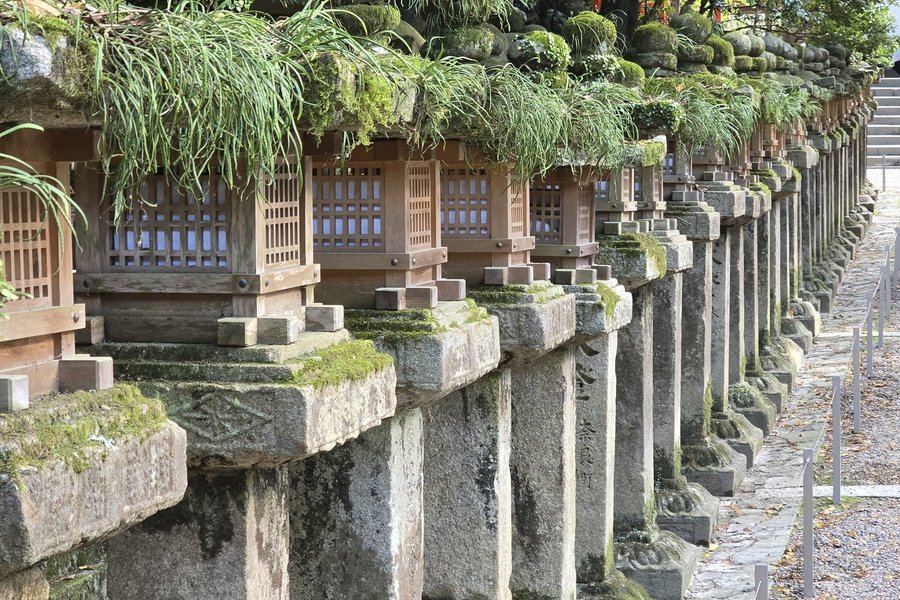
I visited Nara as a full day trip from Kyoto in November 2024. I got first glimpse of the WHS already from the train as the train tracks pass through the Heijo Palace Site! However, it's not much more than a field with some replica gates and walls and seeing it from the train seemed enough.
After arriving to the Kintetsu-Nara station I headed towards the Todai-ji temple by walking. I first visited in Yoshikien Garden, which has free entrance and is very much worth visiting! The garden's exit lead directly to the Namdaimon Gate of Todai-ji (pictured). The gate is very massive and I should have guessed that the size of it was a sign of what was to come. The entrance way towards Todai-ji's Great Buddha Hall is very busy with tourists and deer, and this was the busiest site I visited in Nara. Despite its huge size you won't see the Great Buddha Hall until you enter the ticket office of it. For some reason I wasn't expecting to see such a magnificent building in Nara! And the building was originally even larger! They have miniature replica of the original one inside the hall. The Great Buddha statue is also huge and no photo can make justice of its size. The Great Buddha Hall of Todai-ji is the most impressive temple building I have visited in Japan. After visiting the hall I visited some of the lesser buildings of Todai-ji, like Nigatsu-do which has a balcony …
Keep reading 0 comments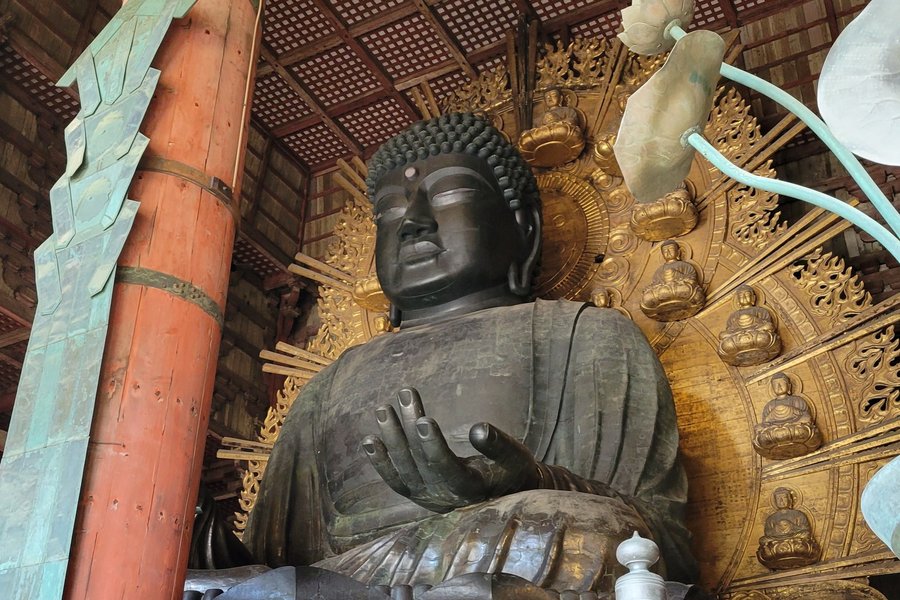
I visited this site for a half-day in the fall of 2023 from Kyoto. This visit was near the end of my trip to Japan, and both my friend and I were both feeling a little bit overwhelmed with the possibility of visiting another WHS composed of several locations. But after an invigorating visit to the Fushimi Inari shrine earlier that morning, during which I hiked to the top, we decided to go for it anyways since neither of us were too tired by that time. We got lunch at a local Nara-zushi restaurant, which was one of my culinary highlights of the trip because the sushi was so unique. The sushi was pressed into a block and wrapped up by some kind of leaf, and it was pretty sour (YUM!).
After our lunch break, we walked over to the Todai-ji temple. We encountered quite a few wandering deer on the way, but as it was the male deer rutting season, we both decided not to invest in the popular deer crackers. That turned out to be a good decision as we saw other travelers getting harassed by gangs of angry and potentially horny deer because they had the crackers.
The buildings of Ancient Nara come from a period of history where Nara was the capital of Japan. Nara was the first capital of Japan hundreds of years before Kyoto, and the differences are visible even to an untrained eye. Unlike Kyoto, which is famous for Zen, Shingon, …
Keep reading 0 comments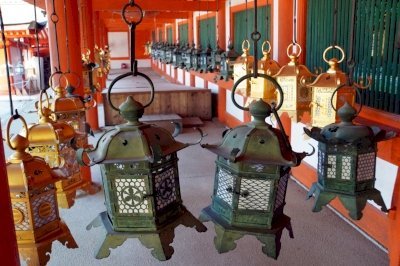
In several ways Ancient Nara is the opposite of the Kyoto WHS. While in Kyoto the temples and shrines are spread all over the entire city area and beyond, the most significant sites in much smaller Nara are located in a park on the edge of the modern city. Nara was the residence of the Japanese Emperor prior to Kyoto, and only for a relatively short time. This may be the reason why the diversity of sites and styles is smaller compared to Kyoto, but that doesn't mean that Nara is also less impressive. Most travelers visit Nara on a day trip from Kyoto. However, I scheduled two full days for Nara and Hōryū-ji, which enabled me to visit all locations of these two WHS.
If you enter the core zone at Sarusawa pond, you first reach Konfuku-ji. In the 8th century, the temple consisted of more than 150 buildings, of which only a few have survived. Most striking is the five-story pagoda. It was completely destroyed several times in civil wars, the current building dates from the 15th century - reconstructions can also be historical, especially in Japan.The must-see in Nara is Todai-ji and its large Buddha statue. Todai-ji is always described in superlatives: largest bronze Buddha statue, largest wooden building in the world. And indeed, everything seems to be at least one size larger than at other temples, not only the Buddha, but also the gates, the guardian statues etc. Over the centuries, Todai-ji (like many …
Keep reading 0 comments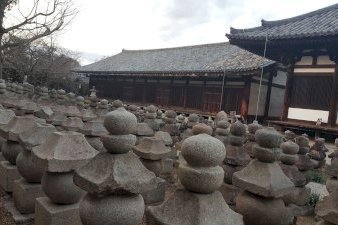
WHS#79
After Kyoto, Nara is definitely the next most important historic city to visit in Japan. Even though it was capital of Japan for far less time, the monuments in Nara are no less impressive. While Ancient Kyoto wins in quantity and diversity of architectural and landscaping styles, Ancient Nara wins in the cohesiveness of its monuments, mostly concentrated in specific areas, most notably Nara Park. It's also home to, in my opinion, the single most impressive temple building in Japan, Todaiji's Daibutsuden. I was able to visit all 4 temples and shrines in and around Nara Park, these being Kasuga Taisha, Todaiji, Kofukuji, and Gangoji on a day trip from Osaka in December 2019. I arrived in JR Nara Station, as I had just come from Horyuji before going to Nara, and from there I took a loop bus to Nara Park.
The normal loop bus doesn't stop at Kasuga Taisha Shrine, but instead drops you almost a kilometer away to walk a forested path through Nara Park towards the shrine. There is a bus from the JR station directly to the shrine, but I believe it's less frequent than the loop bus, and I prefer walking over waiting. Anyway, wherever you get down will most definitely lead to an interaction with the (in)famous deer of Nara. I even saw one steal a plastic bag of donuts from some careless tourists. Nevertheless, they're a great touch to photos, as they seem to have a tendency to pose …
Keep reading 0 comments
One of the many delights of this stunning site, an easy day trip from Kyoto, besides the the two huge carved wooden guardians of the temple, is the admonition near the entrance gate to be careful a deer does not eat your ticket.
Even for those who might feel "templed out" the site is unique and worthy of its world heritage status.
Keep reading 0 comments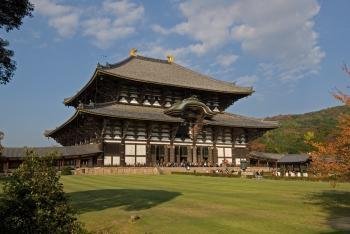
I visited here in 2007.
Nara is a former imperial capital of Japan and served as the capital before Kyoto.
While there are many attractions here, the biggest (literally) is the Todaiji Temple, which is the largest wooden building in the world. It makes for a great bookend with Hyruji if you like wooden building superlatives.
You can visit Nara via a day trip from Kyoto, but I think there is enough there to justify at least an overnight stay if possible.
Read more about the Historic Monuments of Ancient Nara on my website.
Keep reading 0 comments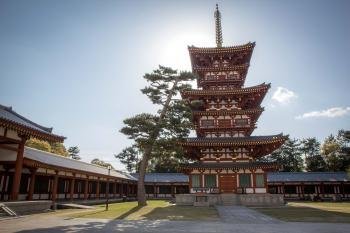
Seven constructions within Nara have been designated as part of an official World Heritage Site. Although there are other things to see, together they form the best examples of the ancient capital and the religious and political significance of the city.
All of them can be seen in a day, if you rush. However my highlights are Todai-ji and Kasuga Grand Shrine.
Keep reading 0 comments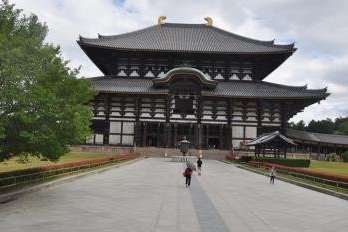
Nara is probably the most underrated historical place anywhere in Japan. Within easy reach of Kansai International Airport by a reliable limousine bus service in just under 90 minutes. But careful: the last trip is at 20.40h. After that just via Osaka. I stayed with Takeshi Hamano at Guesthouse Nara Backpackers (confy beds dorm beds for 23 dollars, wifi and of course tea included) in Yurugi-cho, a very cozy 90 year old wooden building that served in its previous life as a Japanese tea ceremony house. Its quietly and conveniently located inbetween Kintetsu station and Nara-koen, the huge park to the east of the city where you can find most of the temples.Also the park is home to 1,200 deers, freely roaming around in search of shika-sembei, the delicious deer biscuits.At the time of my visit it was the pregnancy season, and I was told that most of the pregnant mama deers are kept indoor (in a place called Rokuen), as they could attack visitors when approached in their string maternal instinct. Rokuen is open for public viewing of the newly born deers during the whole month of June. The highlight of any visit to Nara is of course the world heritage site of Todajij Daibutsu-den which is the largest wooden building in the world. A truly impressive structure, and to imagine that the original building was even wider by about one third of the present size, rebuild in 1709. Inside is yet another world record, the famous Great Buddha …
Keep reading 0 comments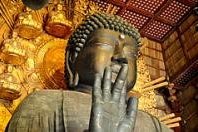
I visited this WHS in November 2009. The highlight of my visit was huge seated Buddha in the Imperial Palace. All the Buddhist temples and Shinto shrines can be explored amidst a Japanese garden setting with the occasional deer grazing freely.
Keep reading 0 comments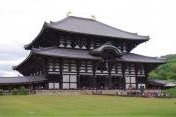
Nara was the first capital city of Japan, in the early 8th century, after the title was moved to Kyoto. However, the city kept its important cultural status in traditional Japan. I have spent three days visiting the numerous marvels of the town.
The Todai ji, a huge temple 56 meters high that houses a huge bronze Buddha statue 16 meters high, is the main attraction. The place is amazing by its greatness and the beauty of the detailed decoration it welcomes. The building deserves the attention it is given.
Very close is Kofuku ji temple with its famous 5 story pagoda, the second tallest in Japan after the one of To ji in Kyoto. While walking in the street and within this temple, you can see and caress the numerous deers that have been living freely in the city for centuries. Their existence is due to the fact that centuries ago, it was decided by one of the leader of the place that deers would not be killed anymore and would be venerated.
Among the other places of interest, we have Gogu ji temple with its Hondo, main hall, and its roof where some part parts are covered with the oldest tiles and the Yakushi ji temple with its colorful buildings.
Keep reading 0 comments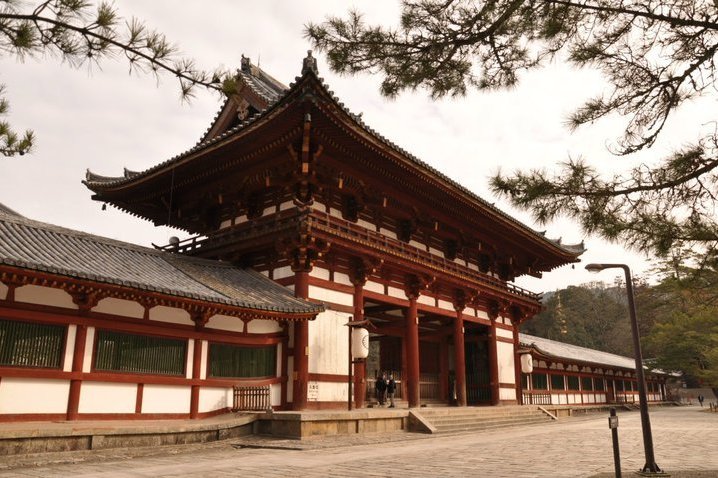
1,300 years old Nara or Heijo-kyo was the first permanent capital of Japan with many ancient beautiful temples and shrines in the one large park that full of hundreds of roaming deer, was maybe the most important tourist attraction after Tokyo and Kyoto. Unlike Kyoto where modern and ancient were combined, Nara was clearly divided into two area, the modern city of Nara in the west and Nara Park with Naramachi area, where most of the main tourist attractions located, in the east.
The must visit places is the grand Todai-ji Temple and the brightly Kasuga Taisha Shrine, the main temple and shrine during Nara was a capital. Todai-ji was well known for its Daibutsu Hall, regarded as the biggest wooden building in the world with gigantic bronze Buddha statue, while Kasuga Taisha was famous for hundreds of stone lanterns decorating the routes to the shrine, and both places were, again, full of deer.
These two places were exceptional and should be seen if in Nara; however my favorite place in Nara and would like to recommend were Kofukuji Temple, its pagoda were the second highest in Japan. The views of Kofukuji at Sarusawa Pond by night were one of the most memorable scenic spots on my every Japan trip. Also, the view of Kofukuji from the outdoor onsen baht of Asukasou Hotel at dusk was totally breathtaking with its eternal serenity, dipping in onsen baht while watching the pagoda was a lifetime experience.
Nara was maybe …
Keep reading 0 comments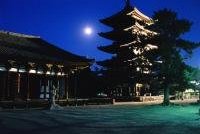
Despite the touristy nature of virtually all of Japan's ancient sites, Nara is one place where you can get some idea of what Japan used to be like before everything old was almost entirely replaced with concrete.
Todai-Ji is a magnificent building and the Daibutsen Buddha is a jaw-dropping spectacle. This is, without question, the star of Nara-Koen and possible the highlight of all of Japan's cultural relics.
The rest of the park is also fascinating, with the 5 storey pagoda of Kofuku-Ji another gem.
The Ancient forest (also on the World Heritage list) at the back of the parkland is well worth hiking around for a few hours. It's a great way to get away from the crowds.
Keep reading 0 comments
My favorite is Gangouji temple. The Gangouji temple is a small, simple, archaic temple. This temple was a place of commoners' prayers from the Middle Ages. It is different from the big temples protected by emperors, aristocrats, and Samurai.
The Gangouji temple is located in an old urban area outside the park. Therefore, few tourists come there. You will be able to see the temple calmly.
(To Mr. Jaxon Nobori's comment. )
A present Daibutsu building was rebuilt in 1709. It is already historical monuments of the Edo shogunate age. There is no reason to destroy it and to rebuild it again.
Keep reading 0 comments
For me, the Toshodai-ji was more interesting than the Todai-ji. In particular the museum with the temples treasures was the highlight for me.
Passed up the chance to gawk at the Daibutsu, but went to see the Shoso-in instead. The central figure is heavily restored and somewhat squat in its' proportions and cramped in its' surroundings. It may help to know that the present building, in only two-thirds the size of the original one. They couldn't find enough big trees to re-build it properly the last time. I'll wait until they re-build it right.
Keep reading 0 comments
